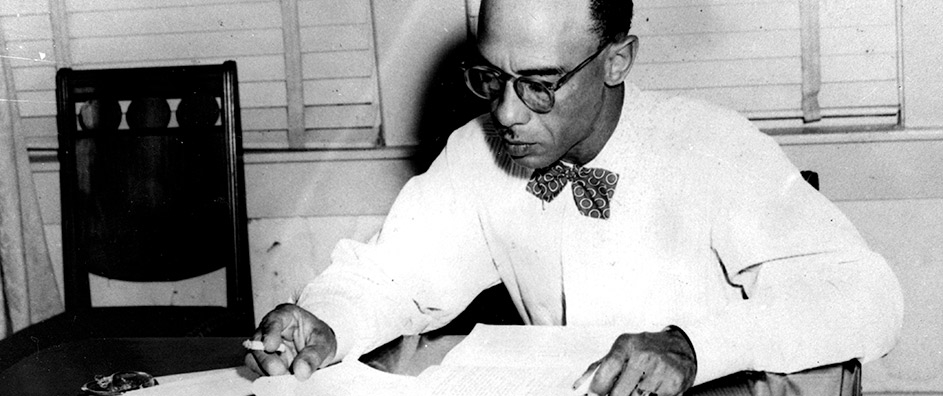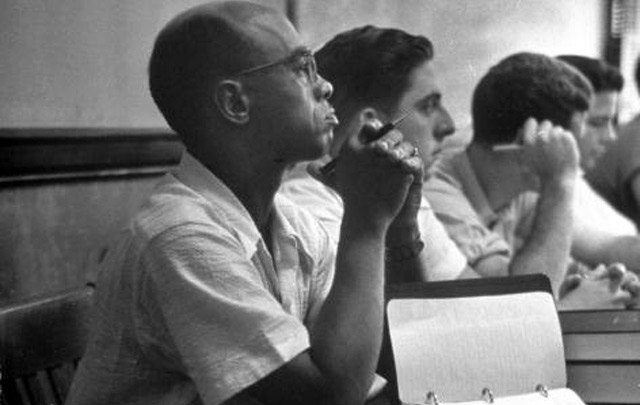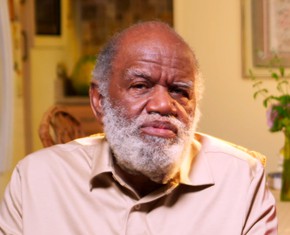Before the famous Brown v. Board of Education case in 1954, a landmark U.S. Supreme Court case called Sweatt vs. Painter successfully contested the “separate but equal” notion of racial segregation.
After being refused admission to the University of Texas School of Law in 1946 on the basis of race, Heman Marion Sweatt, an African-American Baha’i from Houston, took his case to the Texas courts. They ruled against him, citing the Texas state constitution, which mandated segregated education, and ordered the state to establish a law school for blacks.
Unsatisfied with the decision, Mr. Sweatt took the case to the U.S. Supreme Court, represented by the NAACP’s top lawyer, Thurgood Marshall–who went on to serve as the first African-American on the Supreme Court of the United States. In 1950, four years before Brown vs. Board of Education, the Supreme Court decided in Mr. Sweatt’s favor, declaring the Texas black law school inferior.
Celebrating his courage, the December 28, 1946 edition of the Houston Informer bestowed the titles “Man of Texas” and “Texan of the Year” on Mr. Sweatt and said, “What Sweatt has represented shows that the days of Old Black Joe are really gone and the day of Mr. Joseph has come.”
Mr. Sweatt, then 37 and a mail carrier, enrolled in the UT School of Law, but after two years, dropped out of the university. The court battle had taken its toll on his health, marriage and emotional state, the latter due to pressure to excel, the publicity surrounding the case and enduring prejudice. He moved to Atlanta, where he earned a master’s degree in social work and worked for the NAACP and the Urban League.
Mr. Sweatt died in 1982 at the age of 70, but his legacy lives on. He is considered responsible for the establishment of the Texas State University for Negroes (later renamed Texas Southern University), a college for blacks that included a law school.
In 1987, the University of Texas, now a national leader in graduating African-Americans from its law school, inaugurated an annual conference in his name, the Heman Sweatt Symposium on Civil Rights. Also in that year, the UT Little Campus was renamed the Heman Sweatt Campus, and a professorship and scholarship were established in his memory.
“America would not be America today if Heman Sweatt hadn’t done what he did,” says Artemis Kourosh Hubregsen, a Baha’i lawyer from Southlake, Texas. “I learned about Mr. Sweatt as a first-year law student and was touched deeply by his insistence on the oneness of humanity in a Jim Crow era. He is a co-worker and sibling in the Baha’i family, which continues to carry forward all his dearest principles.”
Professor Ernie Young, who teaches constitutional law at the UT law school, calls Sweatt v. Painter “an important way-station on the road to Brown v. Board of Education.”
In his acceptance speech on receiving the Philadelphia Liberty Medal in 1992, Thurgood Marshall called Mr. Sweatt “an ordinary man who had an extraordinary dream to live in a world in which Afro-Americans and Whites alike were afforded equal opportunity to sharpen their minds and to hone their skills.
“Heman Sweatt knew what Whites and Segregationists tried to forget,” Justice Marshall said, “that none of us Afro, White or Blue, will ever rest until we are truly free.”

















Comments
Sign in or create an account
Continue with Googleor